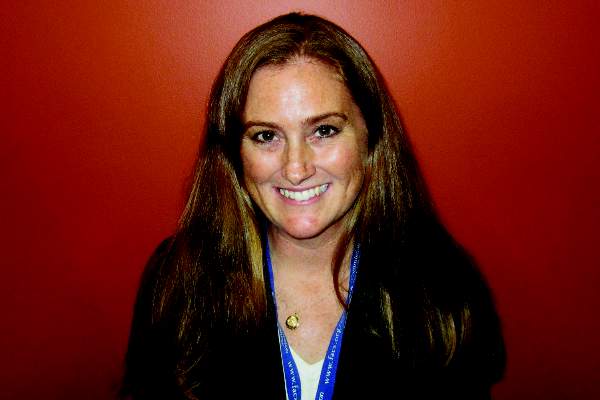User login
M. Alexander Otto began his reporting career early in 1999 covering the pharmaceutical industry for a national pharmacists' magazine and freelancing for the Washington Post and other newspapers. He then joined BNA, now part of Bloomberg News, covering health law and the protection of people and animals in medical research. Alex next worked for the McClatchy Company. Based on his work, Alex won a year-long Knight Science Journalism Fellowship to MIT in 2008-2009. He joined the company shortly thereafter. Alex has a newspaper journalism degree from Syracuse (N.Y.) University and a master's degree in medical science -- a physician assistant degree -- from George Washington University. Alex is based in Seattle.
VIDEO: Hype outstrips evidence on marijuana extracts for childhood epilepsy
SEATTLE – Desperate for help, many parents have tried treating infantile spasms and other childhood epilepsies with cannabidiol oils.
The Internet is full of parents’ testimonials that the marijuana extracts help. Although parents might be on to something, that won’t be known for certain until results are in from randomized, controlled trials about to get underway.
In the meantime, researchers at the University of California, Los Angeles, took a measure of the excitement in a recent anonymous survey of 117 parents.
In a video interview at the annual meeting of the American Epilepsy Society, Dr. Shaun Hussain, director of the infantile spasms program at UCLA and the study’s senior investigator, explained the survey findings and how to counsel parents pending randomized trial results.
The video associated with this article is no longer available on this site. Please view all of our videos on the MDedge YouTube channel
SEATTLE – Desperate for help, many parents have tried treating infantile spasms and other childhood epilepsies with cannabidiol oils.
The Internet is full of parents’ testimonials that the marijuana extracts help. Although parents might be on to something, that won’t be known for certain until results are in from randomized, controlled trials about to get underway.
In the meantime, researchers at the University of California, Los Angeles, took a measure of the excitement in a recent anonymous survey of 117 parents.
In a video interview at the annual meeting of the American Epilepsy Society, Dr. Shaun Hussain, director of the infantile spasms program at UCLA and the study’s senior investigator, explained the survey findings and how to counsel parents pending randomized trial results.
The video associated with this article is no longer available on this site. Please view all of our videos on the MDedge YouTube channel
SEATTLE – Desperate for help, many parents have tried treating infantile spasms and other childhood epilepsies with cannabidiol oils.
The Internet is full of parents’ testimonials that the marijuana extracts help. Although parents might be on to something, that won’t be known for certain until results are in from randomized, controlled trials about to get underway.
In the meantime, researchers at the University of California, Los Angeles, took a measure of the excitement in a recent anonymous survey of 117 parents.
In a video interview at the annual meeting of the American Epilepsy Society, Dr. Shaun Hussain, director of the infantile spasms program at UCLA and the study’s senior investigator, explained the survey findings and how to counsel parents pending randomized trial results.
The video associated with this article is no longer available on this site. Please view all of our videos on the MDedge YouTube channel
AT AES 2014
Hopkins protocol aims to limit sarcoma morcellation risk
VANCOUVER– To minimize the risk of spreading occult malignancy, Johns Hopkins University in Baltimore no longer uses uterine morcellation for fibroids or hysterectomies in women over age 50 years.
Morcellation is also contraindicated under the Hopkins protocol if women have other risk factors for gynecologic cancer, including tamoxifen use, pelvic radiation, hereditary cancer syndromes, and BRCA mutations.
For women who qualify, morcellation can be performed only by high-volume surgeons who isolate their targets within an endoscopy bag to catch spills. Case peer-review, endometrial sampling, and imaging – including an MRI for fibroids – are required beforehand to rule out occult malignancy, and women must be warned of the risk of occult malignancy before opting for morcellation.
“Given the review of our institutional data and recent national debate surrounding power morcellation, our institution developed the protocol to enhance safety for women [undergoing] minimally invasive surgery for benign indications,” said Dr. Stephanie Ricci, a gynecologic oncology fellow at Hopkins.
She explained the protocol just days before the Food and Drug Administration released similar guidance, contraindicating power morcellation in peri- or postmenopausal women, and when tissue can be removed en bloc either vaginally or by mini-laparotomy, which is the case in the majority of hysterectomies and myomectomies. Women must also be warned of the risk of occult malignancy before morcellation, the agency said Nov. 24.
Taken together, the Hopkins’ protocol and the FDA’s guidance could help define the narrow pool of women for whom morcellation might still be an option, be it to preserve fertility or for some other reason.
“It’s possible that a higher rate of peer-review and preop imaging and endometrial sampling counter the risk of occult malignancy,” Dr. Ricci said at a meeting sponsored by AAGL.
Hopkins developed its rules in part based on a review led by Dr. Ricci of 424 morcellation cases there from 2005 to 2014. Two occult cancers were identified in women who underwent power morcellation, giving an incidence of 0.47%.
One case was a 55-year-old woman who presented with pain and hematometra. Her preoperative endometrial biopsy was negative, and she had a preop CT. She was morcellized with endoscopy bag containment and found to have invasive cervical adenocarcinoma. The second case was a 56-year-old women morcellized in 2009 for fibroids with no preoperative imaging, biopsy, or containment bag. She was found to have a uterine sarcoma. Both patients underwent chemotherapy and are currently without evidence of disease.
Almost 90% of the morcellation cases in the series were under age 50 years, 93% had preop uterine imaging, and almost half had preoperative biopsy.
“The one thing our institution has always done, and it speaks to the low rate of sarcoma we found in our study, is that all patients are [reviewed] in a preop gynecological oncology conference, even if they are being taken to the OR for benign indications,” Dr. Ricci said.
Dr. Ricci reported having no financial disclosures.
VANCOUVER– To minimize the risk of spreading occult malignancy, Johns Hopkins University in Baltimore no longer uses uterine morcellation for fibroids or hysterectomies in women over age 50 years.
Morcellation is also contraindicated under the Hopkins protocol if women have other risk factors for gynecologic cancer, including tamoxifen use, pelvic radiation, hereditary cancer syndromes, and BRCA mutations.
For women who qualify, morcellation can be performed only by high-volume surgeons who isolate their targets within an endoscopy bag to catch spills. Case peer-review, endometrial sampling, and imaging – including an MRI for fibroids – are required beforehand to rule out occult malignancy, and women must be warned of the risk of occult malignancy before opting for morcellation.
“Given the review of our institutional data and recent national debate surrounding power morcellation, our institution developed the protocol to enhance safety for women [undergoing] minimally invasive surgery for benign indications,” said Dr. Stephanie Ricci, a gynecologic oncology fellow at Hopkins.
She explained the protocol just days before the Food and Drug Administration released similar guidance, contraindicating power morcellation in peri- or postmenopausal women, and when tissue can be removed en bloc either vaginally or by mini-laparotomy, which is the case in the majority of hysterectomies and myomectomies. Women must also be warned of the risk of occult malignancy before morcellation, the agency said Nov. 24.
Taken together, the Hopkins’ protocol and the FDA’s guidance could help define the narrow pool of women for whom morcellation might still be an option, be it to preserve fertility or for some other reason.
“It’s possible that a higher rate of peer-review and preop imaging and endometrial sampling counter the risk of occult malignancy,” Dr. Ricci said at a meeting sponsored by AAGL.
Hopkins developed its rules in part based on a review led by Dr. Ricci of 424 morcellation cases there from 2005 to 2014. Two occult cancers were identified in women who underwent power morcellation, giving an incidence of 0.47%.
One case was a 55-year-old woman who presented with pain and hematometra. Her preoperative endometrial biopsy was negative, and she had a preop CT. She was morcellized with endoscopy bag containment and found to have invasive cervical adenocarcinoma. The second case was a 56-year-old women morcellized in 2009 for fibroids with no preoperative imaging, biopsy, or containment bag. She was found to have a uterine sarcoma. Both patients underwent chemotherapy and are currently without evidence of disease.
Almost 90% of the morcellation cases in the series were under age 50 years, 93% had preop uterine imaging, and almost half had preoperative biopsy.
“The one thing our institution has always done, and it speaks to the low rate of sarcoma we found in our study, is that all patients are [reviewed] in a preop gynecological oncology conference, even if they are being taken to the OR for benign indications,” Dr. Ricci said.
Dr. Ricci reported having no financial disclosures.
VANCOUVER– To minimize the risk of spreading occult malignancy, Johns Hopkins University in Baltimore no longer uses uterine morcellation for fibroids or hysterectomies in women over age 50 years.
Morcellation is also contraindicated under the Hopkins protocol if women have other risk factors for gynecologic cancer, including tamoxifen use, pelvic radiation, hereditary cancer syndromes, and BRCA mutations.
For women who qualify, morcellation can be performed only by high-volume surgeons who isolate their targets within an endoscopy bag to catch spills. Case peer-review, endometrial sampling, and imaging – including an MRI for fibroids – are required beforehand to rule out occult malignancy, and women must be warned of the risk of occult malignancy before opting for morcellation.
“Given the review of our institutional data and recent national debate surrounding power morcellation, our institution developed the protocol to enhance safety for women [undergoing] minimally invasive surgery for benign indications,” said Dr. Stephanie Ricci, a gynecologic oncology fellow at Hopkins.
She explained the protocol just days before the Food and Drug Administration released similar guidance, contraindicating power morcellation in peri- or postmenopausal women, and when tissue can be removed en bloc either vaginally or by mini-laparotomy, which is the case in the majority of hysterectomies and myomectomies. Women must also be warned of the risk of occult malignancy before morcellation, the agency said Nov. 24.
Taken together, the Hopkins’ protocol and the FDA’s guidance could help define the narrow pool of women for whom morcellation might still be an option, be it to preserve fertility or for some other reason.
“It’s possible that a higher rate of peer-review and preop imaging and endometrial sampling counter the risk of occult malignancy,” Dr. Ricci said at a meeting sponsored by AAGL.
Hopkins developed its rules in part based on a review led by Dr. Ricci of 424 morcellation cases there from 2005 to 2014. Two occult cancers were identified in women who underwent power morcellation, giving an incidence of 0.47%.
One case was a 55-year-old woman who presented with pain and hematometra. Her preoperative endometrial biopsy was negative, and she had a preop CT. She was morcellized with endoscopy bag containment and found to have invasive cervical adenocarcinoma. The second case was a 56-year-old women morcellized in 2009 for fibroids with no preoperative imaging, biopsy, or containment bag. She was found to have a uterine sarcoma. Both patients underwent chemotherapy and are currently without evidence of disease.
Almost 90% of the morcellation cases in the series were under age 50 years, 93% had preop uterine imaging, and almost half had preoperative biopsy.
“The one thing our institution has always done, and it speaks to the low rate of sarcoma we found in our study, is that all patients are [reviewed] in a preop gynecological oncology conference, even if they are being taken to the OR for benign indications,” Dr. Ricci said.
Dr. Ricci reported having no financial disclosures.
AT THE AAGL GLOBAL CONFERENCE
Key clinical point: In addition to the FDA’s recent morcellation contraindications, the procedure shouldn’t be done in women who have uterine sarcoma risk factors.
Major finding: There were two occult malignancies in a series of 424 morcellation cases at Johns Hopkins University, both in women over 50 years old.
Data source: A review of morcellation cases over 9 years.
Disclosures: The lead investigator reported having no financial disclosures.
VIDEO: Psychogenic seizure patients probably okay to drive
SEATTLE – To be safe, neurologists usually tell patients with psychogenic nonepileptic seizures to limit their driving as much as patients with confirmed epilepsy.
That might be an unnecessary restriction on their quality of life, however, according to a study from the Phoenix branch of the Mayo Clinic.
Epileptologist Dr. Kristine Ziemba, who conducted the study while a fellow at the Mayo Clinic, and is now a neurologist in St. Petersburg, Fla., explained why in a video interview at the annual meeting of the American Epilepsy Society.
The video associated with this article is no longer available on this site. Please view all of our videos on the MDedge YouTube channel
SEATTLE – To be safe, neurologists usually tell patients with psychogenic nonepileptic seizures to limit their driving as much as patients with confirmed epilepsy.
That might be an unnecessary restriction on their quality of life, however, according to a study from the Phoenix branch of the Mayo Clinic.
Epileptologist Dr. Kristine Ziemba, who conducted the study while a fellow at the Mayo Clinic, and is now a neurologist in St. Petersburg, Fla., explained why in a video interview at the annual meeting of the American Epilepsy Society.
The video associated with this article is no longer available on this site. Please view all of our videos on the MDedge YouTube channel
SEATTLE – To be safe, neurologists usually tell patients with psychogenic nonepileptic seizures to limit their driving as much as patients with confirmed epilepsy.
That might be an unnecessary restriction on their quality of life, however, according to a study from the Phoenix branch of the Mayo Clinic.
Epileptologist Dr. Kristine Ziemba, who conducted the study while a fellow at the Mayo Clinic, and is now a neurologist in St. Petersburg, Fla., explained why in a video interview at the annual meeting of the American Epilepsy Society.
The video associated with this article is no longer available on this site. Please view all of our videos on the MDedge YouTube channel
AT AES 2014
VIDEO: Curative surgery possible for some kids with LGS epilepsy
SEATTLE– Surgery may cure, or at least greatly help, children with Lennox-Gastaut syndrome who have an abnormality on their brain MRI, according to researchers from the Cleveland Clinic Epilepsy Center.
LGS is a severe form of epilepsy that medications often do not help. Children have multiple seizures per day, with concomitant developmental problems. Until now, surgery has been considered only a palliative option. That may be about to change.
Investigator Dr. Ahsan Valappil, a pediatric epileptologist at the Cleveland Clinic, explained why in an interview at the annual meeting of the American Epilepsy Society.
The video associated with this article is no longer available on this site. Please view all of our videos on the MDedge YouTube channel
SEATTLE– Surgery may cure, or at least greatly help, children with Lennox-Gastaut syndrome who have an abnormality on their brain MRI, according to researchers from the Cleveland Clinic Epilepsy Center.
LGS is a severe form of epilepsy that medications often do not help. Children have multiple seizures per day, with concomitant developmental problems. Until now, surgery has been considered only a palliative option. That may be about to change.
Investigator Dr. Ahsan Valappil, a pediatric epileptologist at the Cleveland Clinic, explained why in an interview at the annual meeting of the American Epilepsy Society.
The video associated with this article is no longer available on this site. Please view all of our videos on the MDedge YouTube channel
SEATTLE– Surgery may cure, or at least greatly help, children with Lennox-Gastaut syndrome who have an abnormality on their brain MRI, according to researchers from the Cleveland Clinic Epilepsy Center.
LGS is a severe form of epilepsy that medications often do not help. Children have multiple seizures per day, with concomitant developmental problems. Until now, surgery has been considered only a palliative option. That may be about to change.
Investigator Dr. Ahsan Valappil, a pediatric epileptologist at the Cleveland Clinic, explained why in an interview at the annual meeting of the American Epilepsy Society.
The video associated with this article is no longer available on this site. Please view all of our videos on the MDedge YouTube channel
AT AES 2014
Watchful waiting is viable option for unruptured ectopic pregnancies
VANCOUVER, B.C. – Waiting a few days to see which way beta–human chorionic gonadotropin levels are headed spares women with unruptured ectopic pregnancies from unnecessary methotrexate treatment, according to an Israeli review of 1,703 ectopic pregnancies over the course of more than 11 years.
Although prompt administration of the drug is standard practice, investigators from Tel Aviv Sourasky Medical Center found that about 40% of ectopic pregnancies resolved on their own without any treatment.
“Our clinical message is that methotrexate is overused. It’s considered a relatively safe drug, but it has its side effects,” said Dr. Yaron Gil, a gynecologist who led the study at Sourasky.
In addition to abdominal cramping and other well-known issues, methotrexate might cause damage to the surrounding fallopian tube and may cause ectopic pregnancies to enlarge, Dr. Gil said at the meeting sponsored by AAGL.
Methotrexate doesn’t resolve the risk of rupture –the main concern with watchful waiting – since ectopic pregnancies can rupture even as the beta-hCG levels decline. A day or two of watchful waiting “doesn’t change the risk of rupture,” Dr. Gil said.
All 1,703 women with ectopic pregnancy were admitted to the hospital between January 2001 and June 2013; 620 (36%) required immediate surgery. The remaining 1,083 women – all hemodynamically stable with beta-hCG levels below 10,000 mIU/mL, no fetal heart activity, and an intervention nearby – were assigned to the watchful waiting protocol.
The investigators measured beta-hCG on admission and followed it daily. Patients who had a daily decline of 15% were considered self-resolving and sent home. Women with a daily increase of 15% or more were treated with methotrexate. Those with daily increases below 15% were followed for a maximum of 5 days, and then given methotrexate.
Among the 1,083 women assigned to the watchful waiting protocol, 674 (62%) had spontaneous resolutions, while 409 (38%) had stable or increasing beta-hCG levels and received methotrexate, 50 mg/m2 IM, usually once, but sometimes twice.
Methotrexate was effective in 356 (87%) of the women who received it. The remainder of the women underwent laparoscopic salpingectomies. Maternal age, parity, gestational age, endometrial thickness, and the size of the ectopic mass had no influence on whether the drug was effective.
In women with beta-hCG levels of 2,500-3,500 mIU/mL, methotrexate was effective 75% of the time. The drug was effective 65% of the time in women with beta-hCG levels greater than 4,500 mIU/mL (Am. J. Obstet. Gynecol. 2014;211:128.e1-5).
As expected, watchful waiting led to a lower rate of methotrexate success than in other reported series because the Israeli team limited use to women who truly needed it, according to Dr. Gil.
“Early administration gives higher success rates, but at the cost of giving methotrexate unnecessarily to some women,” he said. “Longer intervals should be considered before administering the drug.”
Dr. Gil said he has no financial disclosures and didn’t receive outside funding for the study.
VANCOUVER, B.C. – Waiting a few days to see which way beta–human chorionic gonadotropin levels are headed spares women with unruptured ectopic pregnancies from unnecessary methotrexate treatment, according to an Israeli review of 1,703 ectopic pregnancies over the course of more than 11 years.
Although prompt administration of the drug is standard practice, investigators from Tel Aviv Sourasky Medical Center found that about 40% of ectopic pregnancies resolved on their own without any treatment.
“Our clinical message is that methotrexate is overused. It’s considered a relatively safe drug, but it has its side effects,” said Dr. Yaron Gil, a gynecologist who led the study at Sourasky.
In addition to abdominal cramping and other well-known issues, methotrexate might cause damage to the surrounding fallopian tube and may cause ectopic pregnancies to enlarge, Dr. Gil said at the meeting sponsored by AAGL.
Methotrexate doesn’t resolve the risk of rupture –the main concern with watchful waiting – since ectopic pregnancies can rupture even as the beta-hCG levels decline. A day or two of watchful waiting “doesn’t change the risk of rupture,” Dr. Gil said.
All 1,703 women with ectopic pregnancy were admitted to the hospital between January 2001 and June 2013; 620 (36%) required immediate surgery. The remaining 1,083 women – all hemodynamically stable with beta-hCG levels below 10,000 mIU/mL, no fetal heart activity, and an intervention nearby – were assigned to the watchful waiting protocol.
The investigators measured beta-hCG on admission and followed it daily. Patients who had a daily decline of 15% were considered self-resolving and sent home. Women with a daily increase of 15% or more were treated with methotrexate. Those with daily increases below 15% were followed for a maximum of 5 days, and then given methotrexate.
Among the 1,083 women assigned to the watchful waiting protocol, 674 (62%) had spontaneous resolutions, while 409 (38%) had stable or increasing beta-hCG levels and received methotrexate, 50 mg/m2 IM, usually once, but sometimes twice.
Methotrexate was effective in 356 (87%) of the women who received it. The remainder of the women underwent laparoscopic salpingectomies. Maternal age, parity, gestational age, endometrial thickness, and the size of the ectopic mass had no influence on whether the drug was effective.
In women with beta-hCG levels of 2,500-3,500 mIU/mL, methotrexate was effective 75% of the time. The drug was effective 65% of the time in women with beta-hCG levels greater than 4,500 mIU/mL (Am. J. Obstet. Gynecol. 2014;211:128.e1-5).
As expected, watchful waiting led to a lower rate of methotrexate success than in other reported series because the Israeli team limited use to women who truly needed it, according to Dr. Gil.
“Early administration gives higher success rates, but at the cost of giving methotrexate unnecessarily to some women,” he said. “Longer intervals should be considered before administering the drug.”
Dr. Gil said he has no financial disclosures and didn’t receive outside funding for the study.
VANCOUVER, B.C. – Waiting a few days to see which way beta–human chorionic gonadotropin levels are headed spares women with unruptured ectopic pregnancies from unnecessary methotrexate treatment, according to an Israeli review of 1,703 ectopic pregnancies over the course of more than 11 years.
Although prompt administration of the drug is standard practice, investigators from Tel Aviv Sourasky Medical Center found that about 40% of ectopic pregnancies resolved on their own without any treatment.
“Our clinical message is that methotrexate is overused. It’s considered a relatively safe drug, but it has its side effects,” said Dr. Yaron Gil, a gynecologist who led the study at Sourasky.
In addition to abdominal cramping and other well-known issues, methotrexate might cause damage to the surrounding fallopian tube and may cause ectopic pregnancies to enlarge, Dr. Gil said at the meeting sponsored by AAGL.
Methotrexate doesn’t resolve the risk of rupture –the main concern with watchful waiting – since ectopic pregnancies can rupture even as the beta-hCG levels decline. A day or two of watchful waiting “doesn’t change the risk of rupture,” Dr. Gil said.
All 1,703 women with ectopic pregnancy were admitted to the hospital between January 2001 and June 2013; 620 (36%) required immediate surgery. The remaining 1,083 women – all hemodynamically stable with beta-hCG levels below 10,000 mIU/mL, no fetal heart activity, and an intervention nearby – were assigned to the watchful waiting protocol.
The investigators measured beta-hCG on admission and followed it daily. Patients who had a daily decline of 15% were considered self-resolving and sent home. Women with a daily increase of 15% or more were treated with methotrexate. Those with daily increases below 15% were followed for a maximum of 5 days, and then given methotrexate.
Among the 1,083 women assigned to the watchful waiting protocol, 674 (62%) had spontaneous resolutions, while 409 (38%) had stable or increasing beta-hCG levels and received methotrexate, 50 mg/m2 IM, usually once, but sometimes twice.
Methotrexate was effective in 356 (87%) of the women who received it. The remainder of the women underwent laparoscopic salpingectomies. Maternal age, parity, gestational age, endometrial thickness, and the size of the ectopic mass had no influence on whether the drug was effective.
In women with beta-hCG levels of 2,500-3,500 mIU/mL, methotrexate was effective 75% of the time. The drug was effective 65% of the time in women with beta-hCG levels greater than 4,500 mIU/mL (Am. J. Obstet. Gynecol. 2014;211:128.e1-5).
As expected, watchful waiting led to a lower rate of methotrexate success than in other reported series because the Israeli team limited use to women who truly needed it, according to Dr. Gil.
“Early administration gives higher success rates, but at the cost of giving methotrexate unnecessarily to some women,” he said. “Longer intervals should be considered before administering the drug.”
Dr. Gil said he has no financial disclosures and didn’t receive outside funding for the study.
AT THE AAGL GLOBAL CONFERENCE
Key clinical point: Daily monitoring of beta-hCG identifies women who do not need methotrexate for the treatment of ectopic pregnancy.
Major finding: About 40% of ectopic pregnancies will resolve on their own; excluding cases requiring immediate surgery, almost two-thirds will need no treatment.
Data source: A retrospective cohort of 1,703 hospitalized women with ectopic pregnancies between January 2001 and June 2013.
Disclosures: The lead investigator said he has no financial conflicts and received no outside funding for the work.
VIDEO: Ask epilepsy patients about opioid use
SEATTLE – Epilepsy patients were significantly more likely to use opioid analgesics than were matched controls in a review of 2012 Accordant Health Services claims data.
Investigators matched 10,217 patients with epilepsy to 20,542 without epilepsy, based on gender, age, and insurance type. Cancer patients were among those excluded from the study. Based on prescriptions that were filled at least once, analgesic opioids were used by 26% of epilepsy patients versus 18% of controls (P < 0.001).
There was a significantly higher percentage of pain conditions in the epilepsy group, but diversion or other factors could also be at play, lead investigator Dr. Andrew Wilner, a neurologist with Angels Neurological Centers in Abington, Mass., explained at the annual meeting of the American Epilepsy Society.
The investigation is on-going. In the meantime, he said it’s a good idea to ask epilepsy patients about opioid use.
The video associated with this article is no longer available on this site. Please view all of our videos on the MDedge YouTube channel
SEATTLE – Epilepsy patients were significantly more likely to use opioid analgesics than were matched controls in a review of 2012 Accordant Health Services claims data.
Investigators matched 10,217 patients with epilepsy to 20,542 without epilepsy, based on gender, age, and insurance type. Cancer patients were among those excluded from the study. Based on prescriptions that were filled at least once, analgesic opioids were used by 26% of epilepsy patients versus 18% of controls (P < 0.001).
There was a significantly higher percentage of pain conditions in the epilepsy group, but diversion or other factors could also be at play, lead investigator Dr. Andrew Wilner, a neurologist with Angels Neurological Centers in Abington, Mass., explained at the annual meeting of the American Epilepsy Society.
The investigation is on-going. In the meantime, he said it’s a good idea to ask epilepsy patients about opioid use.
The video associated with this article is no longer available on this site. Please view all of our videos on the MDedge YouTube channel
SEATTLE – Epilepsy patients were significantly more likely to use opioid analgesics than were matched controls in a review of 2012 Accordant Health Services claims data.
Investigators matched 10,217 patients with epilepsy to 20,542 without epilepsy, based on gender, age, and insurance type. Cancer patients were among those excluded from the study. Based on prescriptions that were filled at least once, analgesic opioids were used by 26% of epilepsy patients versus 18% of controls (P < 0.001).
There was a significantly higher percentage of pain conditions in the epilepsy group, but diversion or other factors could also be at play, lead investigator Dr. Andrew Wilner, a neurologist with Angels Neurological Centers in Abington, Mass., explained at the annual meeting of the American Epilepsy Society.
The investigation is on-going. In the meantime, he said it’s a good idea to ask epilepsy patients about opioid use.
The video associated with this article is no longer available on this site. Please view all of our videos on the MDedge YouTube channel
AT THE ANNUAL MEETING OF THE AMERICAN EPILEPSY SOCIETY
VIDEO: Drug cocktail stops uterine AVM bleeding
VANCOUVER, B.C. – Bleeding from uterine arteriovenous malformations was stopped with a combination of tranexamic acid, gonadotropin-releasing hormone agonist, and an aromatase inhibitor in a small case series in Canada.
The cocktail appears to be a safe alternative to uterine artery embolization and hysterectomy, which allows women to remain fertile, said Dr. Angelos Vilos, an ob.gyn. at Western University in London, Ontario, and the study’ lead investigator.
Dr. Vilos and his team used uterine tamponade to control bleeding, then gave the women oral tranexamic acid for 5 days. Patients also received a GnRH agonist – usually one injection of leuprolide – with oral letrozole for 5 days after the injection. In all cases, the arteriovenous malformations resolved within 3 months.
In a video interview at the AAGL meeting, Dr. Vilos said the approach could be a “game changer” if it holds up in future testing.
The video associated with this article is no longer available on this site. Please view all of our videos on the MDedge YouTube channel
VANCOUVER, B.C. – Bleeding from uterine arteriovenous malformations was stopped with a combination of tranexamic acid, gonadotropin-releasing hormone agonist, and an aromatase inhibitor in a small case series in Canada.
The cocktail appears to be a safe alternative to uterine artery embolization and hysterectomy, which allows women to remain fertile, said Dr. Angelos Vilos, an ob.gyn. at Western University in London, Ontario, and the study’ lead investigator.
Dr. Vilos and his team used uterine tamponade to control bleeding, then gave the women oral tranexamic acid for 5 days. Patients also received a GnRH agonist – usually one injection of leuprolide – with oral letrozole for 5 days after the injection. In all cases, the arteriovenous malformations resolved within 3 months.
In a video interview at the AAGL meeting, Dr. Vilos said the approach could be a “game changer” if it holds up in future testing.
The video associated with this article is no longer available on this site. Please view all of our videos on the MDedge YouTube channel
VANCOUVER, B.C. – Bleeding from uterine arteriovenous malformations was stopped with a combination of tranexamic acid, gonadotropin-releasing hormone agonist, and an aromatase inhibitor in a small case series in Canada.
The cocktail appears to be a safe alternative to uterine artery embolization and hysterectomy, which allows women to remain fertile, said Dr. Angelos Vilos, an ob.gyn. at Western University in London, Ontario, and the study’ lead investigator.
Dr. Vilos and his team used uterine tamponade to control bleeding, then gave the women oral tranexamic acid for 5 days. Patients also received a GnRH agonist – usually one injection of leuprolide – with oral letrozole for 5 days after the injection. In all cases, the arteriovenous malformations resolved within 3 months.
In a video interview at the AAGL meeting, Dr. Vilos said the approach could be a “game changer” if it holds up in future testing.
The video associated with this article is no longer available on this site. Please view all of our videos on the MDedge YouTube channel
AT THE AAGL GLOBAL CONFERENCE
Start low, go slow with topiramate for alcohol use disorder
SAN FRANCISCO – When naltrexone is not an option for alcohol use disorder, topiramate is a good choice for many patients, according to Dr. Steven L. Batki, psychiatry professor and addiction researcher at the University of California, San Francisco.
Naltrexone is often the first-line option, because it’s relatively inexpensive, simple to dose orally or by injection, and “probably has the greatest evidence” for reducing use and craving, he said at the American Psychiatric Association’s Institute on Psychiatric Services (JAMA 2014;311:1889-1900).
But GI upset is common with the drug, and, like disulfiram, it can cause liver problems. It’s also contraindicated with recent opioid use.
When those are problems, “I would go to topiramate. It reliably reduces craving ... might reduce postwithdrawal dysphoria and anxiety,” and numb the reaction to drinking cues. “There’s quite an effect size for abstinence [versus] placebo.” In some studies, it “works even better than acamprosate or naltrexone,” Dr. Batki said.
The issue with topiramate (Topamax), however, is dose titration. If it’s too fast, the reason for the drug’s slang name – “dopamax” – becomes clear: “excessively rapid up-titration in some patients has led to word searching, and other memory and concentration problems. You can also get paresthesias,” he said.
Because of that, in a study Dr. Batki led that found topiramate reduces alcohol use and hyperarousal in veterans with posttraumatic stress disorder, “we increased the dose very slowly,” starting at 25 mg a day and going up over 6 weeks to 300 mg a day; 300 mg daily is the standard dose, but “I think much lower doses might be effective.” Several studies show as little as 200 mg and perhaps even less may be effective for alcohol use. “We really don’t know what the effective dose is,” he said (Alcohol Clin. Exp. Res. 2014;38:2169-77).
Kidney stones, metabolic acidosis, and narrow angle glaucoma are all possible side effects of the drug, “so anyone who gets eye pain on topiramate” must be taken off immediately. As with other renally excreted alcohol treatment drugs, “cut the dose in half if patients are renally impaired,” Dr. Batki said.
Dosing with another treatment option, gabapentin is generally 600 mg t.i.d., but its effective dose is also “not fully worked out yet.” It seems to increase abstinence and decrease craving but at the cost for some of sedation, dizziness, and edema. “It’s important to check for lower extremity edema. I’ve seen quite a bit of that, especially in women,” he said.
Meanwhile, “there hasn’t been an American study with intention-to-treat analysis where acamprosate has separated from placebo; on secondary analysis it did work. It probably does work.” Dosing is about 2 grams a day, however. “I just haven’t found very many patients who can remember to take two big pills three times a day,” he said.
Dr. Batki has no relevant disclosures.
SAN FRANCISCO – When naltrexone is not an option for alcohol use disorder, topiramate is a good choice for many patients, according to Dr. Steven L. Batki, psychiatry professor and addiction researcher at the University of California, San Francisco.
Naltrexone is often the first-line option, because it’s relatively inexpensive, simple to dose orally or by injection, and “probably has the greatest evidence” for reducing use and craving, he said at the American Psychiatric Association’s Institute on Psychiatric Services (JAMA 2014;311:1889-1900).
But GI upset is common with the drug, and, like disulfiram, it can cause liver problems. It’s also contraindicated with recent opioid use.
When those are problems, “I would go to topiramate. It reliably reduces craving ... might reduce postwithdrawal dysphoria and anxiety,” and numb the reaction to drinking cues. “There’s quite an effect size for abstinence [versus] placebo.” In some studies, it “works even better than acamprosate or naltrexone,” Dr. Batki said.
The issue with topiramate (Topamax), however, is dose titration. If it’s too fast, the reason for the drug’s slang name – “dopamax” – becomes clear: “excessively rapid up-titration in some patients has led to word searching, and other memory and concentration problems. You can also get paresthesias,” he said.
Because of that, in a study Dr. Batki led that found topiramate reduces alcohol use and hyperarousal in veterans with posttraumatic stress disorder, “we increased the dose very slowly,” starting at 25 mg a day and going up over 6 weeks to 300 mg a day; 300 mg daily is the standard dose, but “I think much lower doses might be effective.” Several studies show as little as 200 mg and perhaps even less may be effective for alcohol use. “We really don’t know what the effective dose is,” he said (Alcohol Clin. Exp. Res. 2014;38:2169-77).
Kidney stones, metabolic acidosis, and narrow angle glaucoma are all possible side effects of the drug, “so anyone who gets eye pain on topiramate” must be taken off immediately. As with other renally excreted alcohol treatment drugs, “cut the dose in half if patients are renally impaired,” Dr. Batki said.
Dosing with another treatment option, gabapentin is generally 600 mg t.i.d., but its effective dose is also “not fully worked out yet.” It seems to increase abstinence and decrease craving but at the cost for some of sedation, dizziness, and edema. “It’s important to check for lower extremity edema. I’ve seen quite a bit of that, especially in women,” he said.
Meanwhile, “there hasn’t been an American study with intention-to-treat analysis where acamprosate has separated from placebo; on secondary analysis it did work. It probably does work.” Dosing is about 2 grams a day, however. “I just haven’t found very many patients who can remember to take two big pills three times a day,” he said.
Dr. Batki has no relevant disclosures.
SAN FRANCISCO – When naltrexone is not an option for alcohol use disorder, topiramate is a good choice for many patients, according to Dr. Steven L. Batki, psychiatry professor and addiction researcher at the University of California, San Francisco.
Naltrexone is often the first-line option, because it’s relatively inexpensive, simple to dose orally or by injection, and “probably has the greatest evidence” for reducing use and craving, he said at the American Psychiatric Association’s Institute on Psychiatric Services (JAMA 2014;311:1889-1900).
But GI upset is common with the drug, and, like disulfiram, it can cause liver problems. It’s also contraindicated with recent opioid use.
When those are problems, “I would go to topiramate. It reliably reduces craving ... might reduce postwithdrawal dysphoria and anxiety,” and numb the reaction to drinking cues. “There’s quite an effect size for abstinence [versus] placebo.” In some studies, it “works even better than acamprosate or naltrexone,” Dr. Batki said.
The issue with topiramate (Topamax), however, is dose titration. If it’s too fast, the reason for the drug’s slang name – “dopamax” – becomes clear: “excessively rapid up-titration in some patients has led to word searching, and other memory and concentration problems. You can also get paresthesias,” he said.
Because of that, in a study Dr. Batki led that found topiramate reduces alcohol use and hyperarousal in veterans with posttraumatic stress disorder, “we increased the dose very slowly,” starting at 25 mg a day and going up over 6 weeks to 300 mg a day; 300 mg daily is the standard dose, but “I think much lower doses might be effective.” Several studies show as little as 200 mg and perhaps even less may be effective for alcohol use. “We really don’t know what the effective dose is,” he said (Alcohol Clin. Exp. Res. 2014;38:2169-77).
Kidney stones, metabolic acidosis, and narrow angle glaucoma are all possible side effects of the drug, “so anyone who gets eye pain on topiramate” must be taken off immediately. As with other renally excreted alcohol treatment drugs, “cut the dose in half if patients are renally impaired,” Dr. Batki said.
Dosing with another treatment option, gabapentin is generally 600 mg t.i.d., but its effective dose is also “not fully worked out yet.” It seems to increase abstinence and decrease craving but at the cost for some of sedation, dizziness, and edema. “It’s important to check for lower extremity edema. I’ve seen quite a bit of that, especially in women,” he said.
Meanwhile, “there hasn’t been an American study with intention-to-treat analysis where acamprosate has separated from placebo; on secondary analysis it did work. It probably does work.” Dosing is about 2 grams a day, however. “I just haven’t found very many patients who can remember to take two big pills three times a day,” he said.
Dr. Batki has no relevant disclosures.
EXPERT ANALYSIS AT INSTITUTE ON PSYCHIATRIC SERVICES
Careful screening catches sarcomas before morcellation
VANCOUVER, B.C.– A thorough preop work-up can just about eliminate the risk of accidentally morcellating an occult uterine sarcoma, according to a prospective series of 2,824 women referred for minimally invasive myomectomy to a French university hospital from 2002 to 2013.
The message came just days before the Food and Drug Administration’s Nov. 24 advice not to use power morcellationin the majority of women undergoing hysterectomy or myomectomy for uterine fibroids because “there is no reliable method for predicting whether a woman with fibroids may have a uterine sarcoma” that morcellation could spread. The agency estimated that about 1 in 350 fibroid patients actually have an occult sarcoma.
That’s close to the 1 in 400 incidence investigators at the Lariboisière Hospital in Paris found; the difference is that the French investigators detected all but one of the seven sarcomas in their series before entering the operating room, using a heightened screening protocol. “That’s the major difference between our series and the other series that the” FDA relied on for their advice, said lead investigator and gynecologic surgeon Dr. Afshin Fazel, an assistant professor of obstetrics and gynecology at Lariboisière Hospital.
Physicians at the hospital go further than some to rule out sarcomas prior to fibroid surgery. “Every single patient with a pelvic mass gets an MRI,” as well as a clinical exam and pelvic ultrasound. “If the endometrium is thicker than 4 mm, every patient older than 40 [years old] has endometrial sampling, and if there’s bleeding, every single patient has an office hysteroscopy.” A multidisciplinary team – oncologists, radiologists, gynecologists, and surgeons – review the results and select the appropriate surgical approach, Dr. Fazel said at a meeting sponsored by AAGL.
The screening protocol caught five of the seven sarcomas before surgery. A sixth case, a ruptured uterine sarcoma, presented emergently. All seven women had open surgeries, most had a hysterectomy as their initial operation, and none were morcellated. “The take-home message is that you need all the cards in your hand” to rule out sarcomas before myomectomy. No one screening test is sufficient. Some sarcomas, for instance, don’t have the usual MRI signs; of the three sarcomas the team had detected so far in 2014 – not included in the reported series – just one was found on MRI; the other two were found by endometrial sampling. “Preoperative diagnosis is the key to preventing [accidental] morcellation,” Dr. Fazel said.
The second message is that although “1 out of 400 fibroids in our series were actually sarcomas,” the extra screening meant that “the undiagnosed rate of sarcoma was” 0.035% (or 1 in 2,824), he said.
One of the sarcoma patients was from Taiwan, another was African, and the rest were French. Their age ranged from 38 to 78 years, with a mean age 50 years; two were postmenopausal. They had heavy bleeding and pain, and two had multiple masses. The average size of the uterus was 1,136 cc, and the average size of the mass 891 cc. Four of the seven patients died within 2 years of their surgery.
Among all 2,824 women, two-thirds had minimally invasive approaches, including 743 laparoscopic, 510 hysteroscopic, and 336 vaginal procedures; 262 had uterine artery embolization, which was pioneered by Lariboisière in the late 1980s.
Dr. Fazel said he has no disclosures.
VANCOUVER, B.C.– A thorough preop work-up can just about eliminate the risk of accidentally morcellating an occult uterine sarcoma, according to a prospective series of 2,824 women referred for minimally invasive myomectomy to a French university hospital from 2002 to 2013.
The message came just days before the Food and Drug Administration’s Nov. 24 advice not to use power morcellationin the majority of women undergoing hysterectomy or myomectomy for uterine fibroids because “there is no reliable method for predicting whether a woman with fibroids may have a uterine sarcoma” that morcellation could spread. The agency estimated that about 1 in 350 fibroid patients actually have an occult sarcoma.
That’s close to the 1 in 400 incidence investigators at the Lariboisière Hospital in Paris found; the difference is that the French investigators detected all but one of the seven sarcomas in their series before entering the operating room, using a heightened screening protocol. “That’s the major difference between our series and the other series that the” FDA relied on for their advice, said lead investigator and gynecologic surgeon Dr. Afshin Fazel, an assistant professor of obstetrics and gynecology at Lariboisière Hospital.
Physicians at the hospital go further than some to rule out sarcomas prior to fibroid surgery. “Every single patient with a pelvic mass gets an MRI,” as well as a clinical exam and pelvic ultrasound. “If the endometrium is thicker than 4 mm, every patient older than 40 [years old] has endometrial sampling, and if there’s bleeding, every single patient has an office hysteroscopy.” A multidisciplinary team – oncologists, radiologists, gynecologists, and surgeons – review the results and select the appropriate surgical approach, Dr. Fazel said at a meeting sponsored by AAGL.
The screening protocol caught five of the seven sarcomas before surgery. A sixth case, a ruptured uterine sarcoma, presented emergently. All seven women had open surgeries, most had a hysterectomy as their initial operation, and none were morcellated. “The take-home message is that you need all the cards in your hand” to rule out sarcomas before myomectomy. No one screening test is sufficient. Some sarcomas, for instance, don’t have the usual MRI signs; of the three sarcomas the team had detected so far in 2014 – not included in the reported series – just one was found on MRI; the other two were found by endometrial sampling. “Preoperative diagnosis is the key to preventing [accidental] morcellation,” Dr. Fazel said.
The second message is that although “1 out of 400 fibroids in our series were actually sarcomas,” the extra screening meant that “the undiagnosed rate of sarcoma was” 0.035% (or 1 in 2,824), he said.
One of the sarcoma patients was from Taiwan, another was African, and the rest were French. Their age ranged from 38 to 78 years, with a mean age 50 years; two were postmenopausal. They had heavy bleeding and pain, and two had multiple masses. The average size of the uterus was 1,136 cc, and the average size of the mass 891 cc. Four of the seven patients died within 2 years of their surgery.
Among all 2,824 women, two-thirds had minimally invasive approaches, including 743 laparoscopic, 510 hysteroscopic, and 336 vaginal procedures; 262 had uterine artery embolization, which was pioneered by Lariboisière in the late 1980s.
Dr. Fazel said he has no disclosures.
VANCOUVER, B.C.– A thorough preop work-up can just about eliminate the risk of accidentally morcellating an occult uterine sarcoma, according to a prospective series of 2,824 women referred for minimally invasive myomectomy to a French university hospital from 2002 to 2013.
The message came just days before the Food and Drug Administration’s Nov. 24 advice not to use power morcellationin the majority of women undergoing hysterectomy or myomectomy for uterine fibroids because “there is no reliable method for predicting whether a woman with fibroids may have a uterine sarcoma” that morcellation could spread. The agency estimated that about 1 in 350 fibroid patients actually have an occult sarcoma.
That’s close to the 1 in 400 incidence investigators at the Lariboisière Hospital in Paris found; the difference is that the French investigators detected all but one of the seven sarcomas in their series before entering the operating room, using a heightened screening protocol. “That’s the major difference between our series and the other series that the” FDA relied on for their advice, said lead investigator and gynecologic surgeon Dr. Afshin Fazel, an assistant professor of obstetrics and gynecology at Lariboisière Hospital.
Physicians at the hospital go further than some to rule out sarcomas prior to fibroid surgery. “Every single patient with a pelvic mass gets an MRI,” as well as a clinical exam and pelvic ultrasound. “If the endometrium is thicker than 4 mm, every patient older than 40 [years old] has endometrial sampling, and if there’s bleeding, every single patient has an office hysteroscopy.” A multidisciplinary team – oncologists, radiologists, gynecologists, and surgeons – review the results and select the appropriate surgical approach, Dr. Fazel said at a meeting sponsored by AAGL.
The screening protocol caught five of the seven sarcomas before surgery. A sixth case, a ruptured uterine sarcoma, presented emergently. All seven women had open surgeries, most had a hysterectomy as their initial operation, and none were morcellated. “The take-home message is that you need all the cards in your hand” to rule out sarcomas before myomectomy. No one screening test is sufficient. Some sarcomas, for instance, don’t have the usual MRI signs; of the three sarcomas the team had detected so far in 2014 – not included in the reported series – just one was found on MRI; the other two were found by endometrial sampling. “Preoperative diagnosis is the key to preventing [accidental] morcellation,” Dr. Fazel said.
The second message is that although “1 out of 400 fibroids in our series were actually sarcomas,” the extra screening meant that “the undiagnosed rate of sarcoma was” 0.035% (or 1 in 2,824), he said.
One of the sarcoma patients was from Taiwan, another was African, and the rest were French. Their age ranged from 38 to 78 years, with a mean age 50 years; two were postmenopausal. They had heavy bleeding and pain, and two had multiple masses. The average size of the uterus was 1,136 cc, and the average size of the mass 891 cc. Four of the seven patients died within 2 years of their surgery.
Among all 2,824 women, two-thirds had minimally invasive approaches, including 743 laparoscopic, 510 hysteroscopic, and 336 vaginal procedures; 262 had uterine artery embolization, which was pioneered by Lariboisière in the late 1980s.
Dr. Fazel said he has no disclosures.
AT THE AAGL GLOBAL CONFERENCE
Key clinical point: It’s possible to catch most sarcomas before fibroid morcellation.
Major finding: One in 400 women with fibroids have an occult sarcoma; preoperative MRI, pelvic ultrasound, endometrial sampling, and hysteroscopy reduces the chance that they will undergo morcellation to 0.035%.
Data source: Prospective case series of 2,824 women referred for minimally invasive myomectomy to a university hospital in Paris.
Disclosures: Dr. Fazel said he has no financial conflicts.
Antibiotic bowel prep significantly reduces colon surgery infections
SAN FRANCISCO – Oral antibiotics with mechanical bowel preparation significantly reduce surgical site infections, length of hospital stay, and readmissions in both open and laparoscopic elective colorectal surgery, according to a review of 8,415 cases in the National Surgery Quality Improvement Program.
It “should be adopted for elective colorectal surgery,” concluded the investigators, led by colorectal surgeon Melanie Morris of the University of Alabama at Birmingham.
A quarter of the patients had no bowel prep, 45% had mechanical prep alone – GoLytely or another laxative, and 30% received both oral antibiotics and mechanical prep. Partial colectomy and sigmoid resections were the most common procedures, generally for neoplasms or diverticulitis.
Overall, 15% of the no-prep group, 12% of the mechanical prep group, and 6.5% of the oral antibiotic plus mechanical prep group developed subsequent surgical site infections (SSIs), a statistically significant difference. Results were similar when broken down into superficial, deep wound, and organ space infections (J. Am. Coll. Surg. 2014:219;S18-19).
On multivariate analysis and after adjusting for diabetes, smoking, age, and other potential confounders, the antibiotic group was 54% less likely than the no-prep group to develop an SSI (odds ratio 0.46), 26% less likely to be readmitted (OR 0.74), and more likely to leave the hospital earlier, at about 4 days instead of 5 (OR 0.90). SSIs and readmissions were only slightly less likely in the mechanical prep–only group, compared with the no-prep group, and there was no difference in length of stay.
There were fewer anastomotic leaks, fewer cases of sepsis, less significant bleeding, and other benefits for oral antibiotics with mechanical preparation. In addition, there was a protective effect against 30-day mortality in open procedures.
“Even in the minimally invasive group,” about two-thirds of patients, “oral antibiotic prep … was protective for surgical site infections,” Dr. Morris said at the annual clinical congress of the American College of Surgeons.
Still, bowel prep remains “a very controversial topic.” Nationwide some surgeons prep, some don’t. “People have very strong beliefs that may or may not be rooted in the data,” she said.
There are concerns about fluid and electrolyte disturbances, Clostridium difficile overgrowth, and other potential problems. Plus, mechanical preparation hasn’t worked any better than placebo in recent studies, but many of those studies didn’t include oral antibiotics. Effective bowel prep includes both, Dr. Morris said.
It’s possible that confounders might have been at work in the Alabama study. Perhaps surgeons shied away from bowel prep in older, sicker patients, but the rate of acute renal injury was the same in all three study groups at about 0.9%, suggesting similar background comorbidities.
“I don’t think confounding issues” explain the findings. Previously, “we’ve shown the benefit of oral antibiotic bowel prep in a [Veterans Affairs] cohort, and now we’ve shown it in this national cohort,” Dr. Morris said (Dis. Colon. Rectum 2012;55:1160-6).
After a marked reduction in surgical site infections in the VA study, “we changed our practices. We now do mechanical and oral antibiotic preps and have seen a 50% reduction in our SSI rate. We don’t feel like we are doing anything else differently,” she said.
Dr. Morris has no disclosures.
SAN FRANCISCO – Oral antibiotics with mechanical bowel preparation significantly reduce surgical site infections, length of hospital stay, and readmissions in both open and laparoscopic elective colorectal surgery, according to a review of 8,415 cases in the National Surgery Quality Improvement Program.
It “should be adopted for elective colorectal surgery,” concluded the investigators, led by colorectal surgeon Melanie Morris of the University of Alabama at Birmingham.
A quarter of the patients had no bowel prep, 45% had mechanical prep alone – GoLytely or another laxative, and 30% received both oral antibiotics and mechanical prep. Partial colectomy and sigmoid resections were the most common procedures, generally for neoplasms or diverticulitis.
Overall, 15% of the no-prep group, 12% of the mechanical prep group, and 6.5% of the oral antibiotic plus mechanical prep group developed subsequent surgical site infections (SSIs), a statistically significant difference. Results were similar when broken down into superficial, deep wound, and organ space infections (J. Am. Coll. Surg. 2014:219;S18-19).
On multivariate analysis and after adjusting for diabetes, smoking, age, and other potential confounders, the antibiotic group was 54% less likely than the no-prep group to develop an SSI (odds ratio 0.46), 26% less likely to be readmitted (OR 0.74), and more likely to leave the hospital earlier, at about 4 days instead of 5 (OR 0.90). SSIs and readmissions were only slightly less likely in the mechanical prep–only group, compared with the no-prep group, and there was no difference in length of stay.
There were fewer anastomotic leaks, fewer cases of sepsis, less significant bleeding, and other benefits for oral antibiotics with mechanical preparation. In addition, there was a protective effect against 30-day mortality in open procedures.
“Even in the minimally invasive group,” about two-thirds of patients, “oral antibiotic prep … was protective for surgical site infections,” Dr. Morris said at the annual clinical congress of the American College of Surgeons.
Still, bowel prep remains “a very controversial topic.” Nationwide some surgeons prep, some don’t. “People have very strong beliefs that may or may not be rooted in the data,” she said.
There are concerns about fluid and electrolyte disturbances, Clostridium difficile overgrowth, and other potential problems. Plus, mechanical preparation hasn’t worked any better than placebo in recent studies, but many of those studies didn’t include oral antibiotics. Effective bowel prep includes both, Dr. Morris said.
It’s possible that confounders might have been at work in the Alabama study. Perhaps surgeons shied away from bowel prep in older, sicker patients, but the rate of acute renal injury was the same in all three study groups at about 0.9%, suggesting similar background comorbidities.
“I don’t think confounding issues” explain the findings. Previously, “we’ve shown the benefit of oral antibiotic bowel prep in a [Veterans Affairs] cohort, and now we’ve shown it in this national cohort,” Dr. Morris said (Dis. Colon. Rectum 2012;55:1160-6).
After a marked reduction in surgical site infections in the VA study, “we changed our practices. We now do mechanical and oral antibiotic preps and have seen a 50% reduction in our SSI rate. We don’t feel like we are doing anything else differently,” she said.
Dr. Morris has no disclosures.
SAN FRANCISCO – Oral antibiotics with mechanical bowel preparation significantly reduce surgical site infections, length of hospital stay, and readmissions in both open and laparoscopic elective colorectal surgery, according to a review of 8,415 cases in the National Surgery Quality Improvement Program.
It “should be adopted for elective colorectal surgery,” concluded the investigators, led by colorectal surgeon Melanie Morris of the University of Alabama at Birmingham.
A quarter of the patients had no bowel prep, 45% had mechanical prep alone – GoLytely or another laxative, and 30% received both oral antibiotics and mechanical prep. Partial colectomy and sigmoid resections were the most common procedures, generally for neoplasms or diverticulitis.
Overall, 15% of the no-prep group, 12% of the mechanical prep group, and 6.5% of the oral antibiotic plus mechanical prep group developed subsequent surgical site infections (SSIs), a statistically significant difference. Results were similar when broken down into superficial, deep wound, and organ space infections (J. Am. Coll. Surg. 2014:219;S18-19).
On multivariate analysis and after adjusting for diabetes, smoking, age, and other potential confounders, the antibiotic group was 54% less likely than the no-prep group to develop an SSI (odds ratio 0.46), 26% less likely to be readmitted (OR 0.74), and more likely to leave the hospital earlier, at about 4 days instead of 5 (OR 0.90). SSIs and readmissions were only slightly less likely in the mechanical prep–only group, compared with the no-prep group, and there was no difference in length of stay.
There were fewer anastomotic leaks, fewer cases of sepsis, less significant bleeding, and other benefits for oral antibiotics with mechanical preparation. In addition, there was a protective effect against 30-day mortality in open procedures.
“Even in the minimally invasive group,” about two-thirds of patients, “oral antibiotic prep … was protective for surgical site infections,” Dr. Morris said at the annual clinical congress of the American College of Surgeons.
Still, bowel prep remains “a very controversial topic.” Nationwide some surgeons prep, some don’t. “People have very strong beliefs that may or may not be rooted in the data,” she said.
There are concerns about fluid and electrolyte disturbances, Clostridium difficile overgrowth, and other potential problems. Plus, mechanical preparation hasn’t worked any better than placebo in recent studies, but many of those studies didn’t include oral antibiotics. Effective bowel prep includes both, Dr. Morris said.
It’s possible that confounders might have been at work in the Alabama study. Perhaps surgeons shied away from bowel prep in older, sicker patients, but the rate of acute renal injury was the same in all three study groups at about 0.9%, suggesting similar background comorbidities.
“I don’t think confounding issues” explain the findings. Previously, “we’ve shown the benefit of oral antibiotic bowel prep in a [Veterans Affairs] cohort, and now we’ve shown it in this national cohort,” Dr. Morris said (Dis. Colon. Rectum 2012;55:1160-6).
After a marked reduction in surgical site infections in the VA study, “we changed our practices. We now do mechanical and oral antibiotic preps and have seen a 50% reduction in our SSI rate. We don’t feel like we are doing anything else differently,” she said.
Dr. Morris has no disclosures.
AT THE ACS CLINICAL CONGRESS
Key clinical point: Effective bowel prep must include oral antibiotics as well as laxatives.
Major finding: Prepping colorectal surgery patients with both oral antibiotics and laxatives halves the risk of surgery site infections (OR 0.46, 95% CI 0.36-0.59, P < .001),
Data source: Review of 8,415 cases in the National Surgery Quality Improvement Program
Disclosures: Dr. Morris has no relevant financial disclosures.














